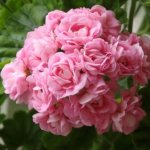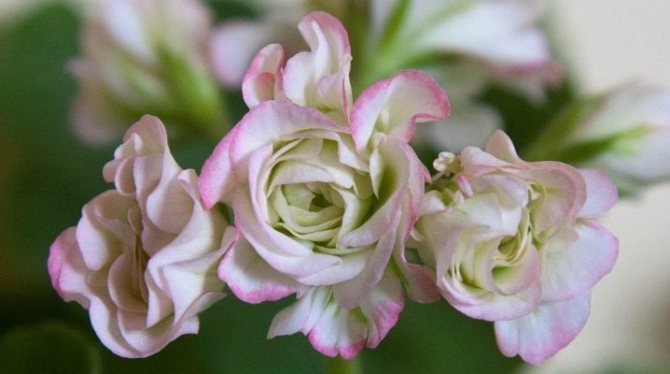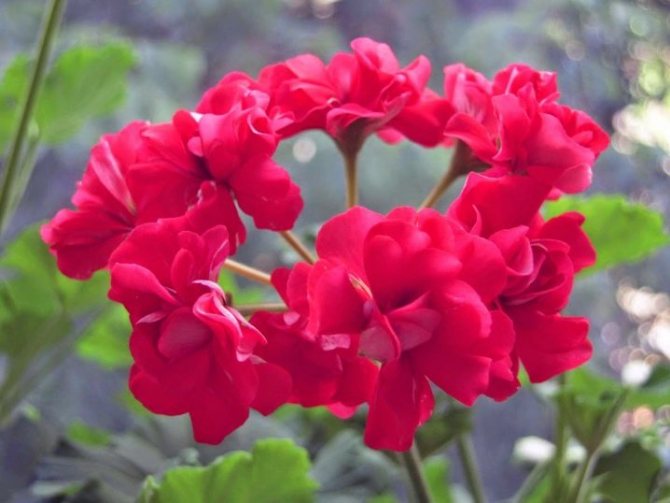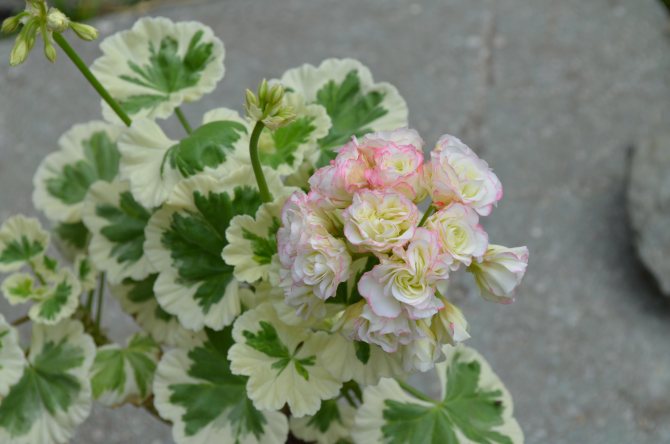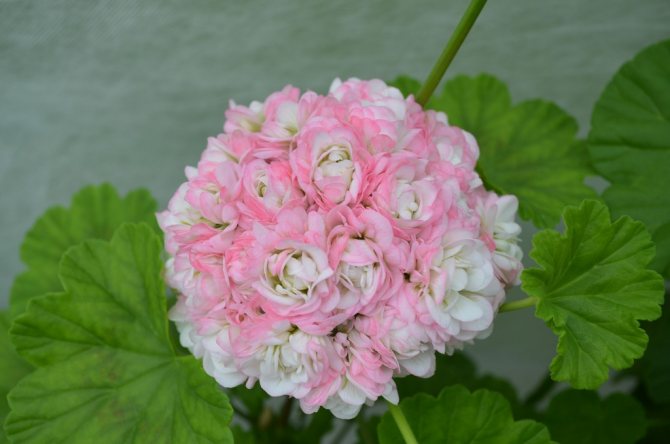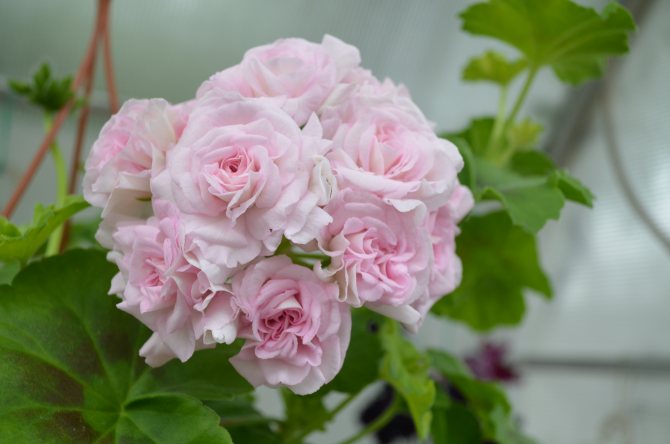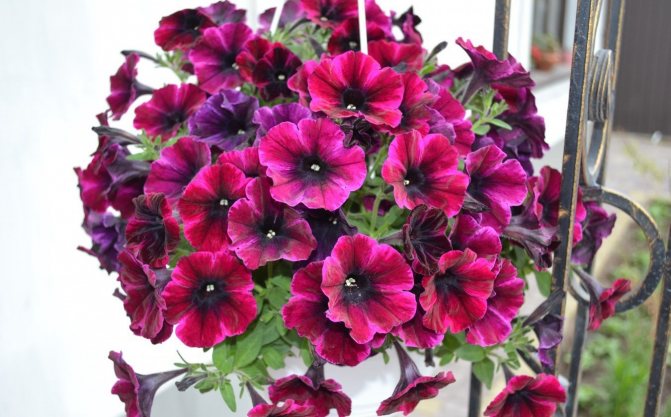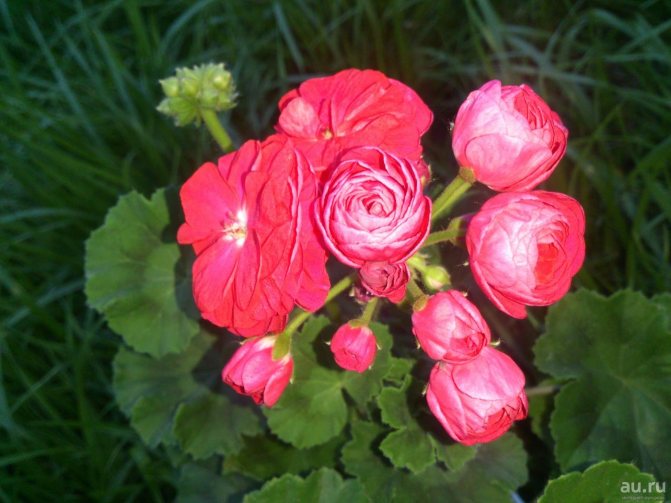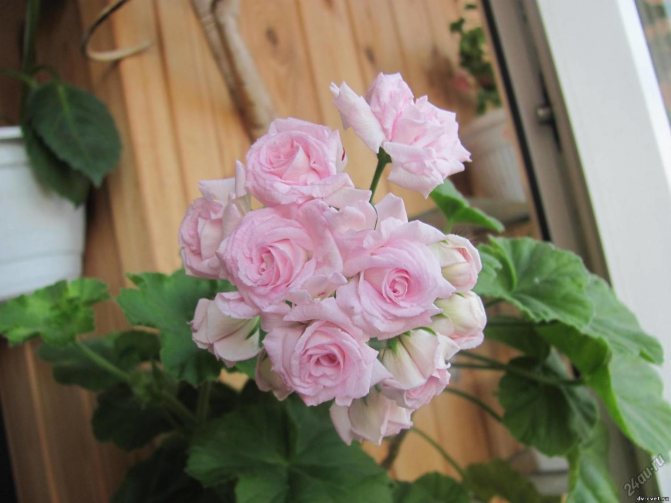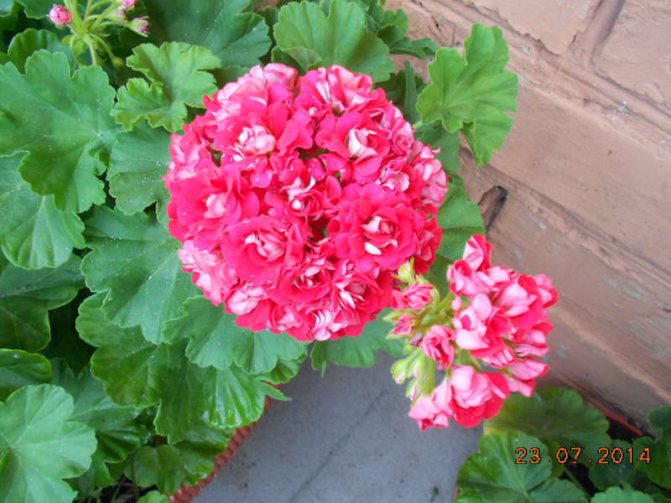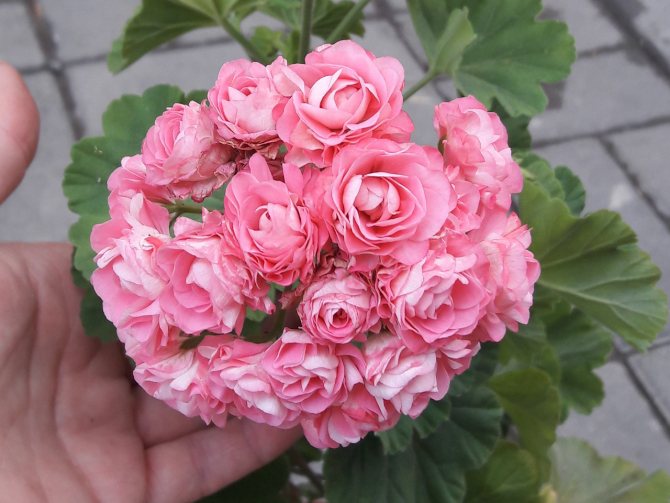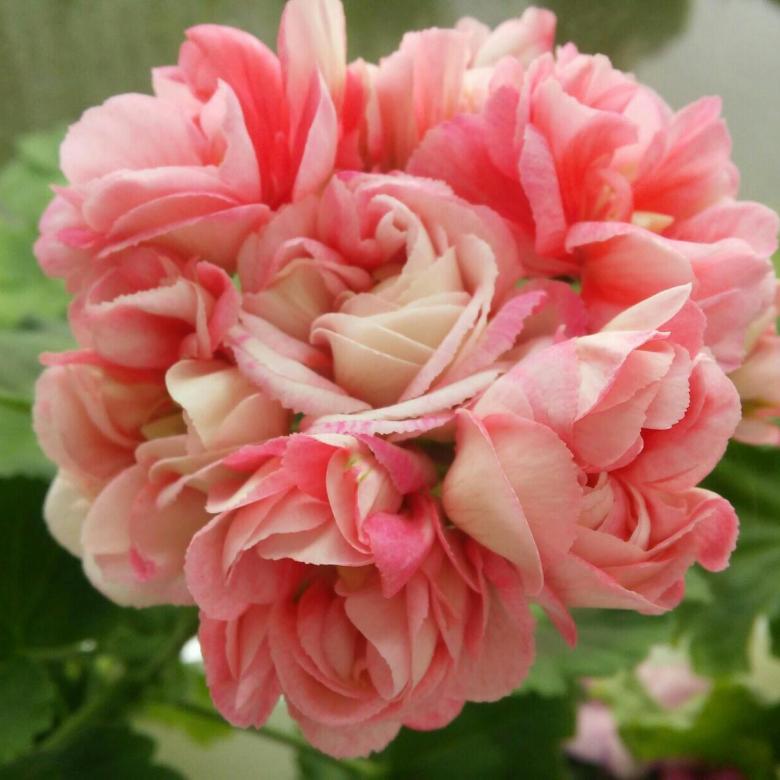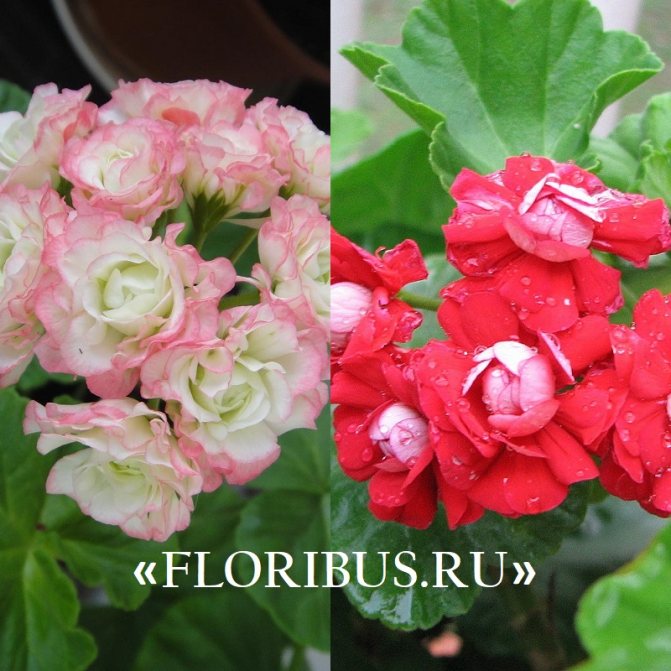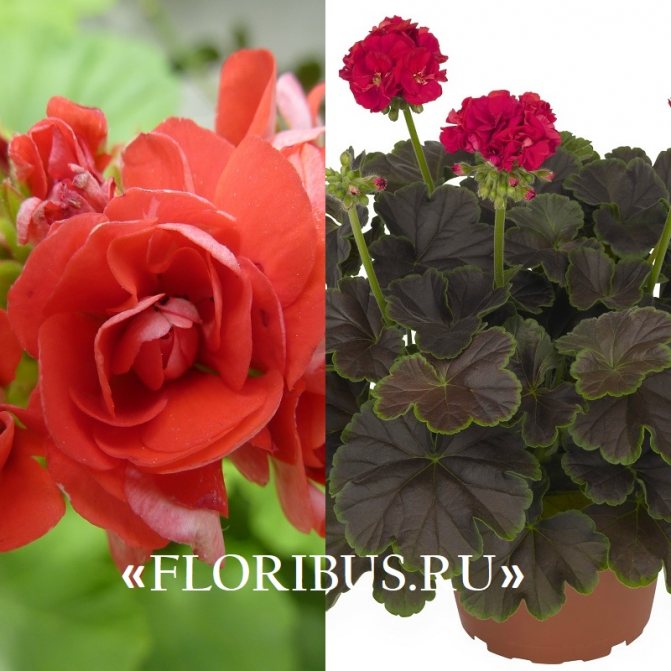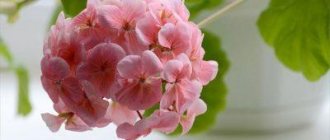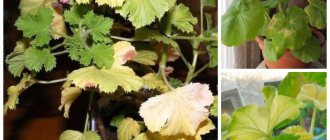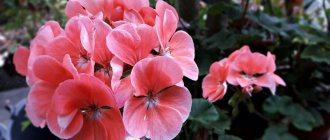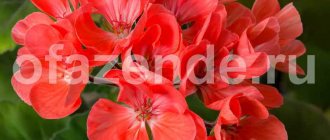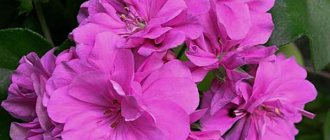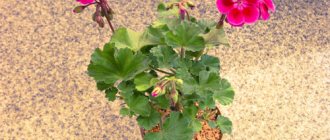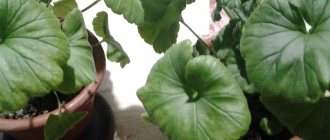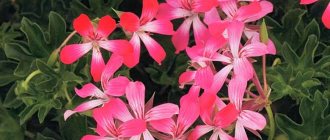On the territory of the southern tip of Africa, there is a region with a rich flora - this is the Cape region, the birthplace of the rosebud geranium. It was from there that the colonialists brought her to the Old World. Pelargonium gained wide popularity in the 18th century - first in England, then in Europe and Russia. The usual name for us home geranium is not directly related to pelargonium, they are united only by the large Geranium family. Unlike real geraniums, pelargonium is a houseplant used for landscaping streets only in summer.
Geranium, a wild and cultivated garden plant that hibernates at very low temperatures. Geranium rosebud (or rosaceous) was obtained by random mutation at the end of the 19th century in France. She inspired flower growers to breed such pelargoniums in different groups, as a result of which varieties of zonal, ivy and dwarf rosebud pelargonium were obtained.
Its miniature buds consist of many petals and outwardly resemble small roses.
Almost all geraniums have a specific smell due to the high content of essential oils. The smell is so pleasant that it was diluted with more expensive oils or passed off as rose oil.
Modern breeders have developed varieties with smells:
- roses;
- lemon;
- chocolate;
- needles;
- lavender.
Oils are widely used in medicine and beauticians. Pelargonium is able to cleanse the air from pathogenic bacteria and saturate the room with phytoncides. Endow the plant with mystical abilities. Popular beliefs speak of the ability of a flower to influence the fate of the owner for the better, to help him in establishing family affairs and solving financial problems.
Description
Pelargonium rosebud flower growers are often called geraniums. These are indeed plants from the same family, although they do not resemble each other either in leaves or the main decorative part.
Wild geraniums can be seen in the forest. She attracts attention with modest blue flowers. There are also special varieties for the garden with flowers ranging from white to almost black (through the red spectrum). The plant is cold resistant.
Pelargonium is a resident of the southern regions. In Russia, she often lives indoors. Balconies and verandas are decorated with it only for the summer.
And even if they are planted in the ground, by the end of the warm season they are returned under the roof.
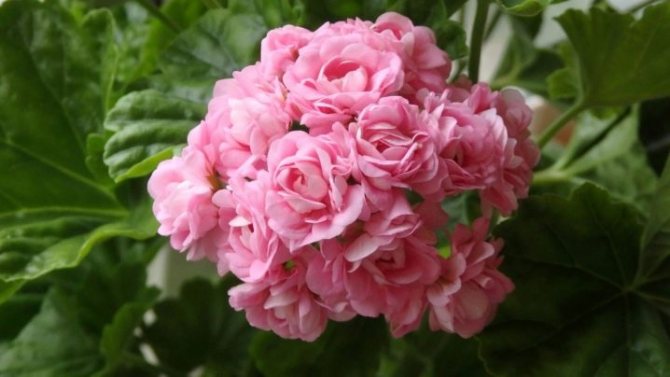
Blossoms with beautiful umbrellas. You can find a green beauty with white, pink or deep red buds. She does not have blue flowers. The bush reaches a height of 80 centimeters.
The similarity between pelargonium and geranium is that they have nearly identical seed pods.
Pelargonium rosebud appeared in the 19th century on the territory of Europe due to a mutation. The fashion for growing such wonderful roses originated in England. They were used to make bouquets. At the same time, amazing bushes were brought to Russia.
There are about 250 types of pelargonium. They are subdivided:
- on ampelous ones - with flexible stems that hang down beautifully or curl along the surfaces;
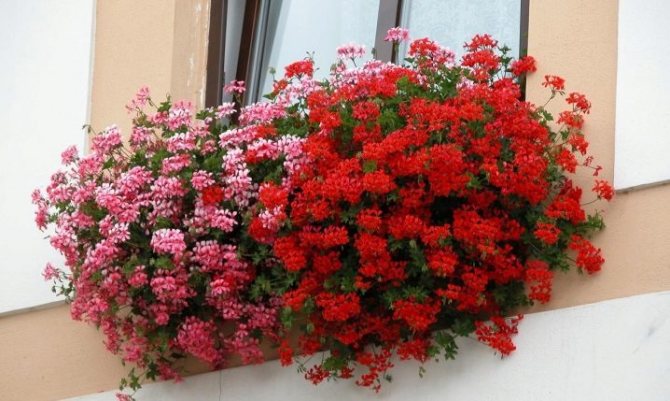

- zonal - straight bushes with dense foliage and small flowers;
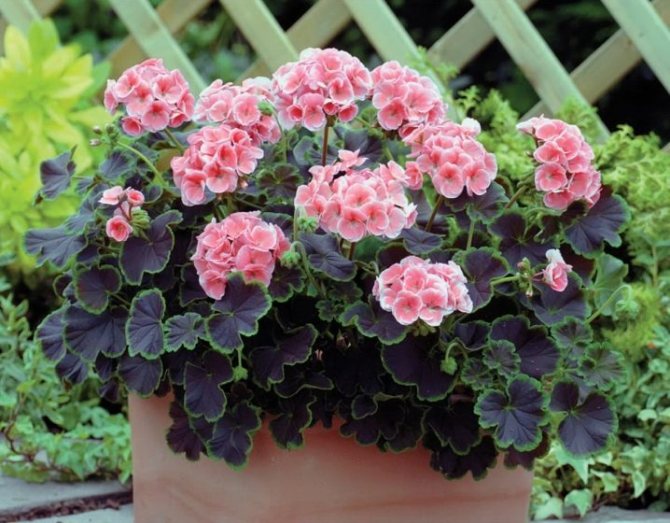

- dwarf - small plants, most suitable for use in the house;
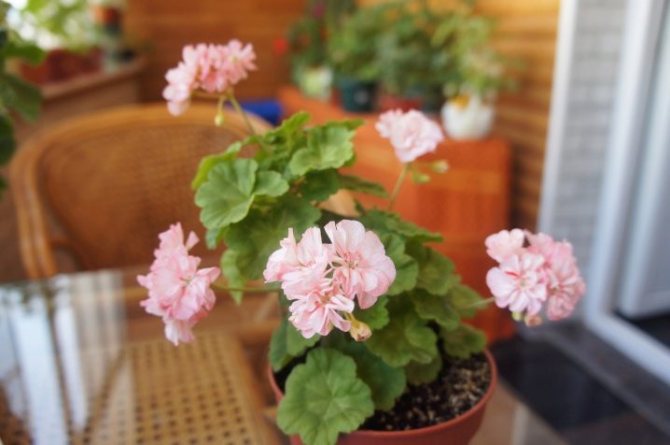

- ivy hybrids that combine the properties of all three varieties.
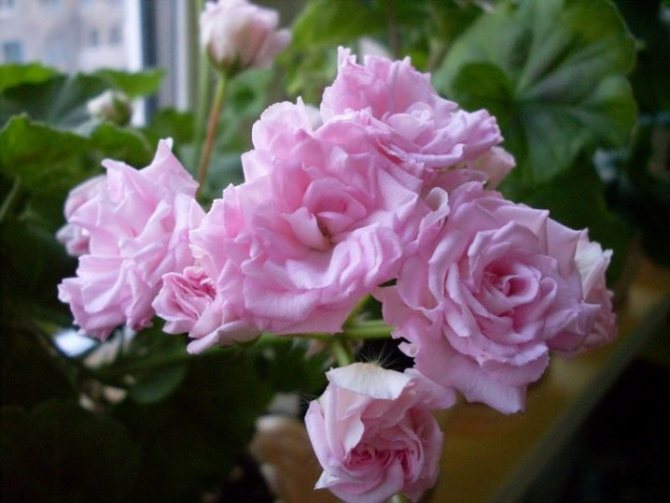

Among the brightest and most popular varieties, the following can be distinguished.
- Vectis Rosebud. A miniature-looking shrub with clusters of small roses of a bright red hue. It blooms luxuriantly for several months. Allows you to easily form a crown.
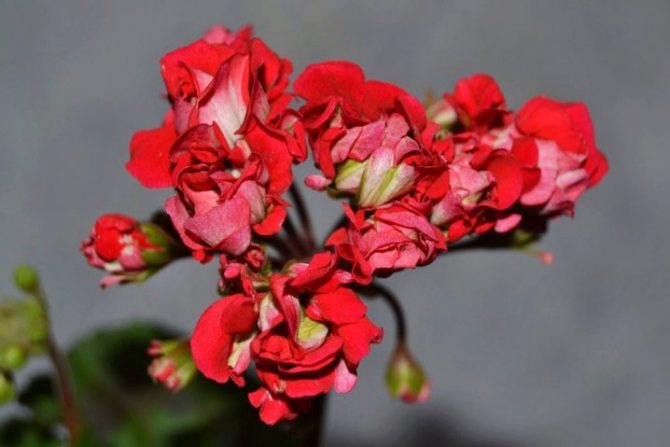

- Pink rambler. A strong-looking bush with corrugated leaves and flowers of a rich pink hue. The petals are beautifully shaped, lighter from the inside out. Easy to care for, pleases with the beauty of its buds throughout the warm season.
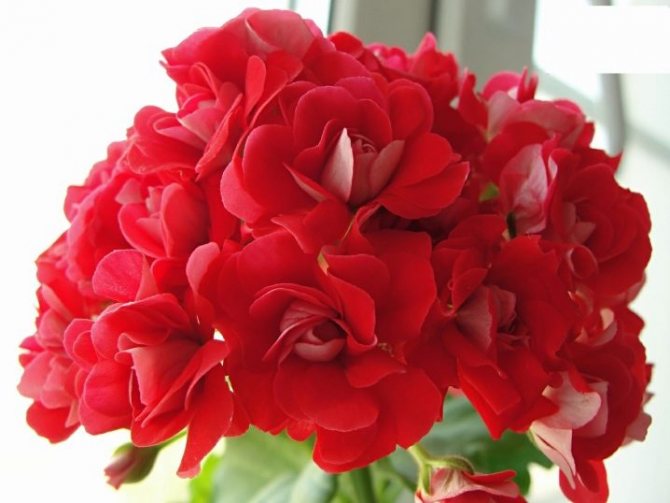

- Monseruds Rosen. Blooms in red flowers with a purple tint. Because of this color, the buds give the impression of being heavy and rich in appearance. There are also Monseruds Rosen with white dots on the petals. This variety is not easy to grow because it has many side shoots. Crown formation requires constant attention.
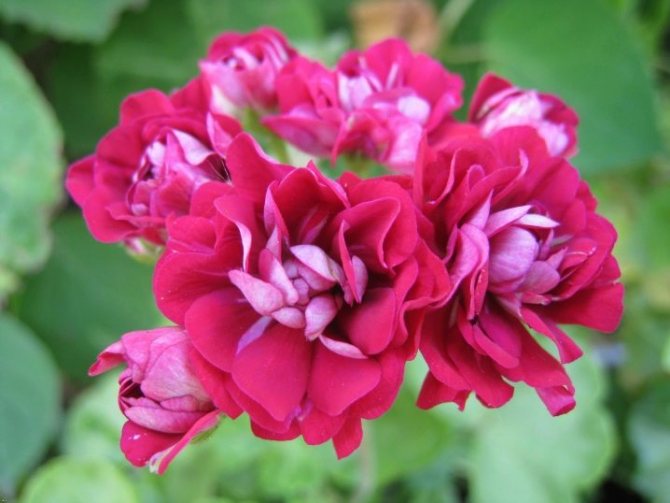

- Apple Blossom. It is a perennial bush, on the tops of which beautiful dense umbrellas of white double flowers with a pink border grow. The bush grows rapidly. It needs to be pruned constantly. If this is not done, the processes begin to stretch out strongly, losing foliage. Because of this, the plant loses its attractiveness.
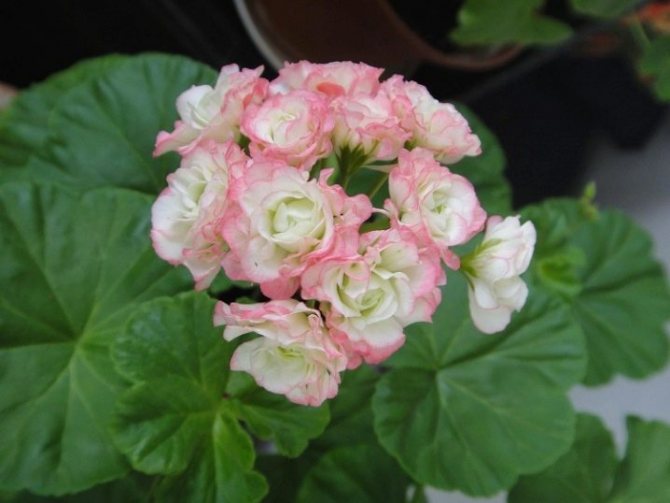

- Supreme. Blooms late in lush red bouquets of small roses. The bush is not difficult to care for and easily lends itself to crown formation.
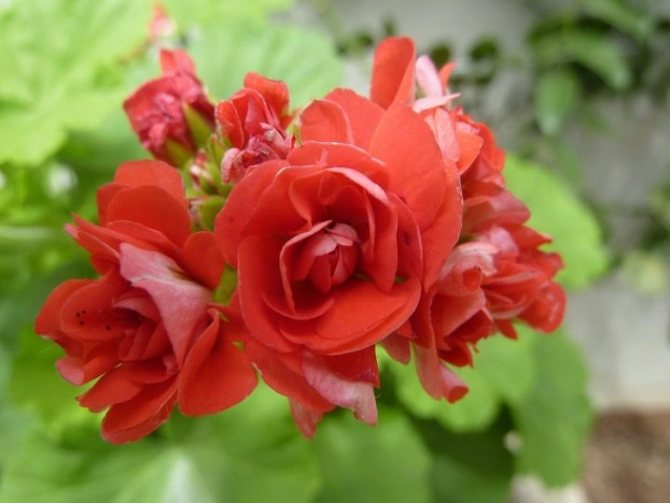

- Millfield Rose. Hybrid pelargonium with large pink buds, collected in dense inflorescences. It is often used for landscaping, as it tolerates temperature changes well. It begins to bloom in the second year of life.
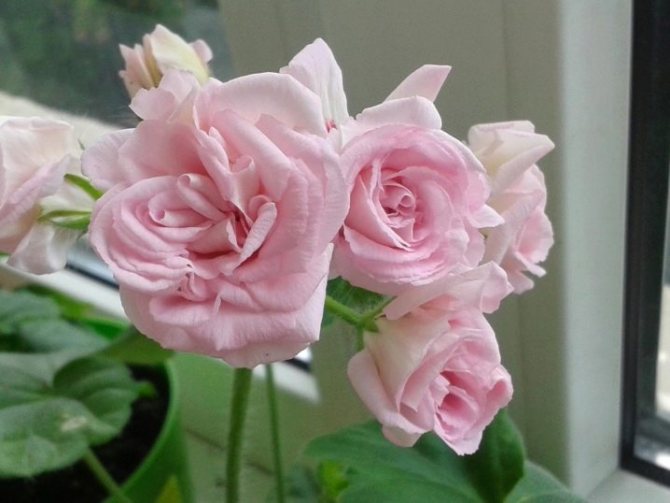

- Unicorn zonartic rose... It is a compact bush with large - up to 8 cm - double pink-red flowers. The variety is unpretentious, the bushes provide lush flowering.
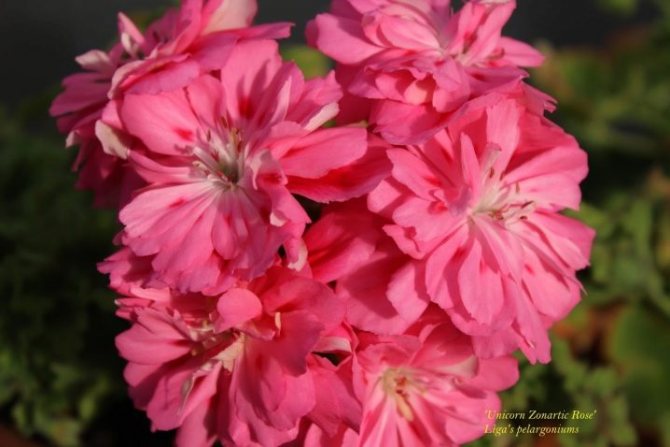

- Jubilee Rose. The petals of a rich purple or fuchsia color with their texture resemble corrugated paper with wavy edges. This pelargonium pleases with colored voluminous caps of lush flowers. The plant itself looks like a sturdy bush with leaves closely spaced to each other.
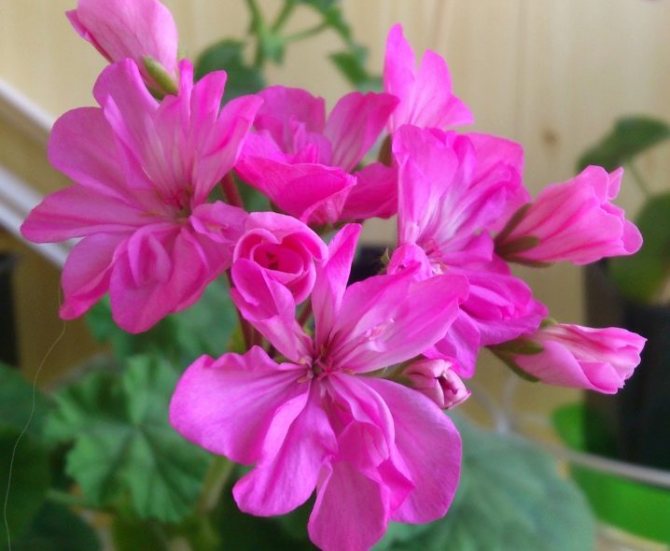

- Ice Rose. A deep green bush with shiny thick leaves. It grows slowly. White roses reach 6 centimeters in size.
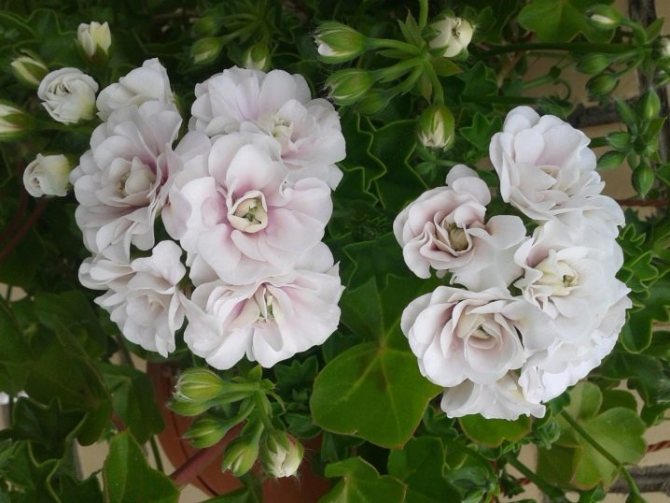

- Grainger's Antique Rose. A plant with rounded leaves characteristic of pelargonium. It blooms with large roses of extraordinary appearance with a silky texture, collected in beautiful hats.
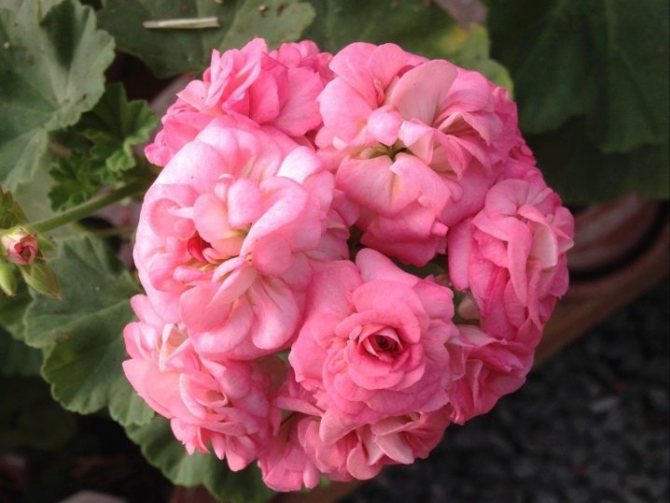

- Brookside Rosa. Unusual miniature zonal bush. It has bright leaves and rich pink petals. It grows and bushes quickly. Therefore, you need to cut off the stretching shoots in time.
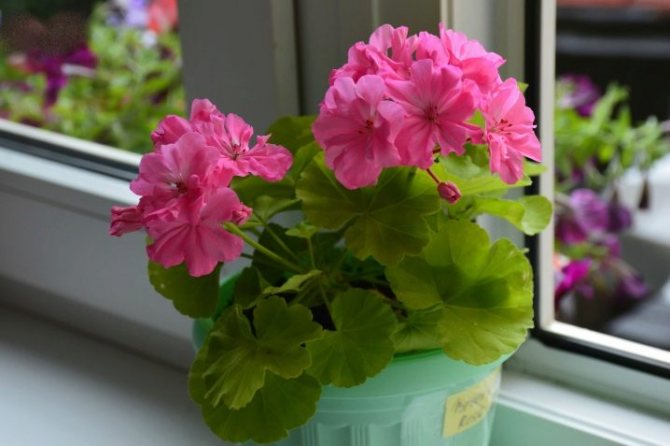

- Australian pink rosebud. A hybrid that appeared in Australia through the efforts of local breeders. The plant resembles a real bush rose and requires gentle handling. He has pink buds of the correct shape, as if not fully opened. Leaves of rich green color serve as an excellent frame for the roses themselves, collected in large inflorescences.
In appearance, the bush is strong, with a large number of lateral shoots.
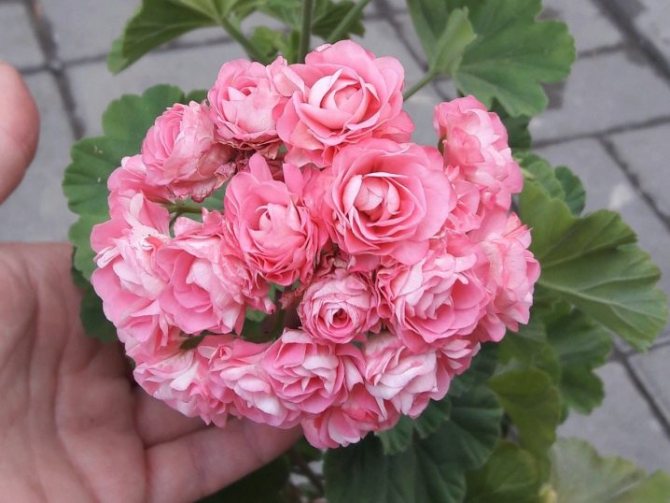

- Marbacka Rose. The plant stretches quickly as it grows, does not need pruning and does not require much effort to keep it healthy. The fluffy flowers, collected in large clusters, have pink buds of a delicate shade, as well as having a tone close to skin tone. Such pelargonium blooms almost continuously, it easily takes root.
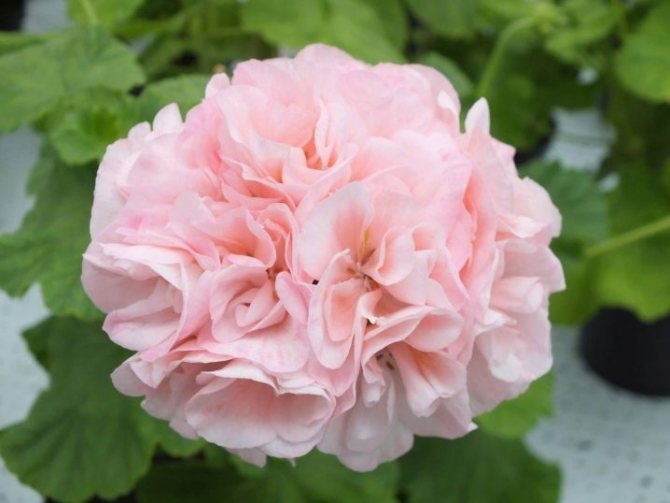

- "Night Rose". It is a bush about 30 centimeters high. The leaves are brown. Pink-purple buds are collected in large spherical inflorescences. If properly cared for, pelargonium will delight with flowering all year round.
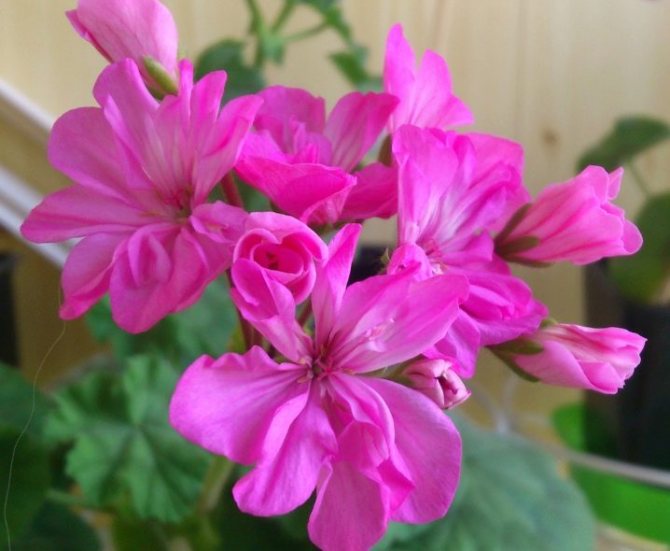

- Milfield Rose. It is a bush with voluminous and heavy-looking pale pink buds, similar to real roses. The stems of the plant branch, they have many leaves. This variety is in great demand among flower growers.
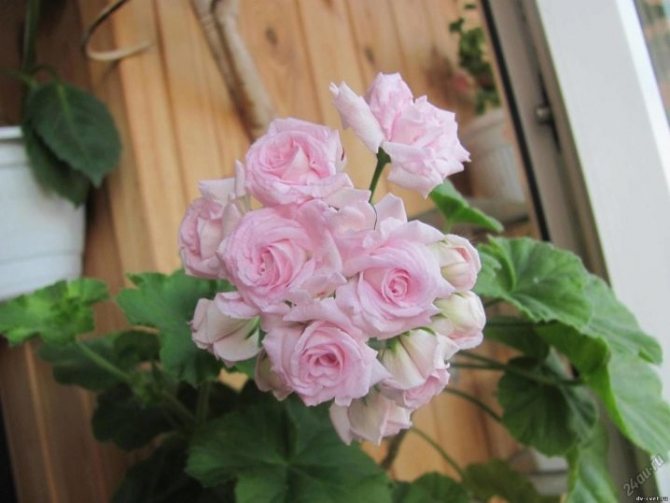

- Bornholm. A massive bush with bright red double, like satin, buds, collected in beautiful brushes. The petals unfold slowly and not completely. But the flowers that have appeared delight with their appearance for a long time. The plant requires close attention, since if it grows strongly, it will not be able to bloom.
Breeding history
Pelargonium Rosebudnaya has recently enjoyed increased popularity not only among collectors of rare varieties of flowers, but also among novice florists. The thing is that in terms of external parameters, it is similar to roses. This is a group of zoned pelargoniums, which have certain differences from other varieties. Terry flowers of this group of plants have many petals that do not allow the flower to fully bloom, because of this, the half-opened bud visually resembles a rose flower.
Pelargonium Swanland Pink is a decorative flower that came to Russia from Australia. A variety with fairly large peduncles that are able to stay on the stem for a month, if the optimal temperature regime is observed. Based on the name, it is clear that the color of this plant is pale pink. It can bloom about 3 times per season. The number of peduncles depends on the correct care and maintenance of the flower. The variety was bred directionally by botanist Arthur Langley Smith in 1827. The result was the selection of curly pelargonium and brilliant geranium.
Pelargonium Swanland Pink
Landing
In order to plant an adult plant on a site for a warm period, you need to do this by the transshipment method. That is, remove the entire clod of earth, captured by the roots, from the pot and plant it in the ground.
Before starting the planting process itself, you need to cut off the shoots that are strongly branching. Days in February and early March are suitable for such work. After the procedure, the pelargonium is placed on the sunny side, they begin to water more often (preferably in a tray). The disembarkation is done when the real warmth comes.
If the bush remains at home, it still needs to change its habitat, since the available soil is depleted.
Planting works in the new land are carried out in April.
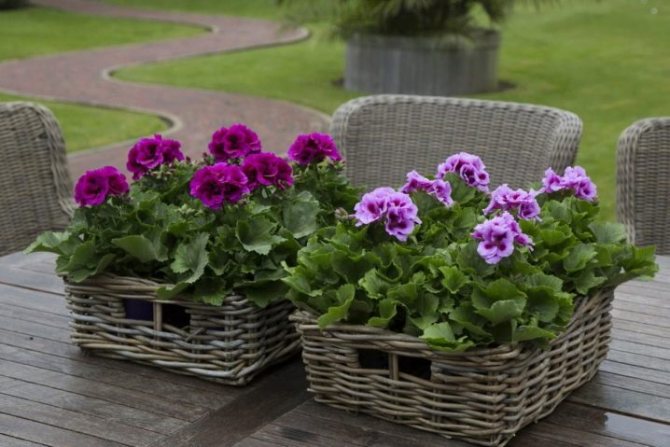

You can buy fresh soil for pelargonium in the store or make a suitable composition yourself. The substrate is prepared from a mixture of peat, perlite, sand, turf, humus.
In order for a new beautiful plant to appear in the house or in the garden, cuttings are planted, which are cut from March to July. You can take a half-stiff one and containing up to five internodes. The leaves are removed, and the cut is dried for half an hour.
A mixture of soil and vermiculite suitable for pelargonium is best suited for planting.
Before the procedure, they are mixed in equal proportions.
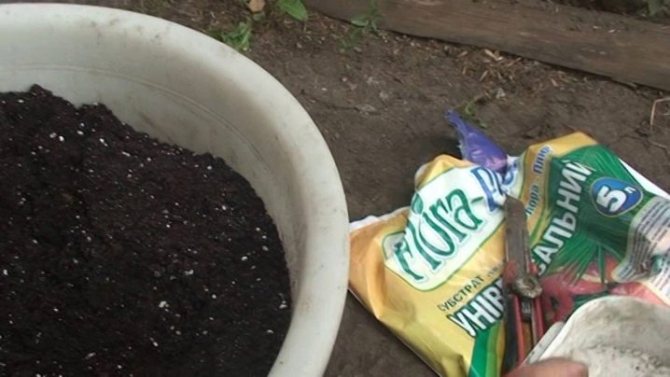

The pot is pre-disinfected. The container size should be slightly larger than the roots. If the dishes are too large, you will not wait for flowering, but in a small one, pelargonium will wither.
After planting the cuttings, light watering is carried out at regular intervals. After 3 weeks, the stalk will take root. This will be indicated by new shoots that have appeared on it. When the bush grows, you can give it symmetry by pruning.
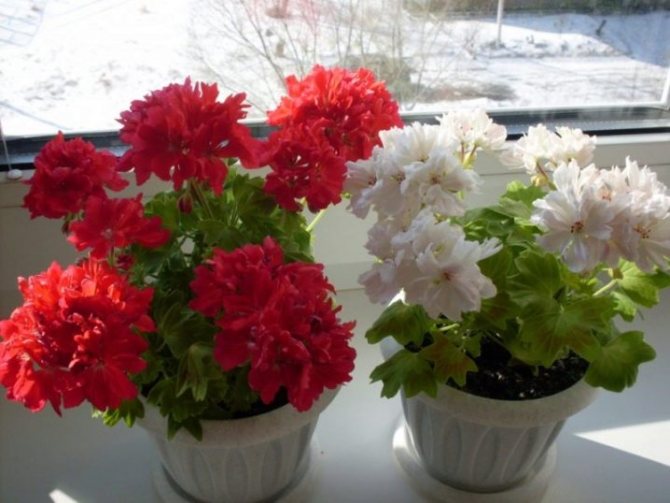

If the bush grows in open ground, you need to water it when the soil underneath dries up. It is easier to be a little late with watering than to do it often and abundantly. Such generosity of pelargonium is useless. Because of this, the root will rot and the plant will die. It is necessary to moisten the soil in the early morning. The same approach is practiced in relation to the beautiful pelargonium growing at home.
Before you start watering, just touch the ground with your fingers. If traces remain on the skin, you should not rush to moisturize.
In order for the flower to please the owners with lush buds for a long time, it must be properly fed. While there is a parade of roses, mineral fertilizers are applied to the soil once a month.
These are complex formulations with a high content of phosphorus and potassium.
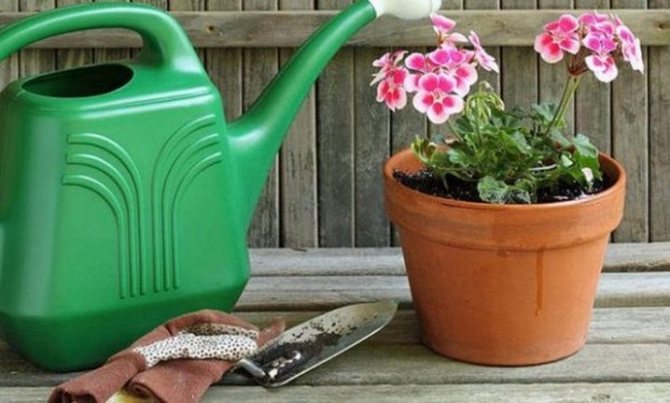

Nitrogen fertilizers are not needed during this period. If the bush is supplied with this very substance, it will direct its power to build up the green mass, and the flowering will stop. Such fertilizers are good for pelargonium in the fall, when it is prepared for winter.
In winter, the flower has a dormant period. At this time, the bush must be placed in a shaded corner with a temperature of about +14 degrees.
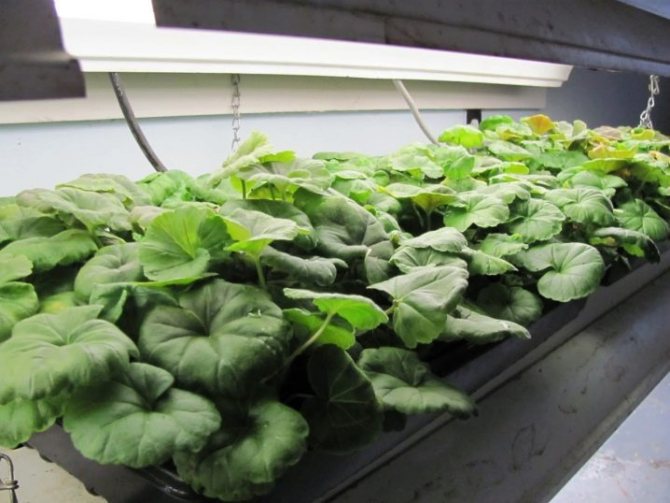

It should be borne in mind that pelargonium loves light, but not direct sunlight. If the light intensity is too high, the leaves of the plant dry out, and the stems turn yellow and become lethargic. Increased watering will not solve this problem.
So that burns do not appear on the leaf plates, the flower has a healthy appearance and blooms, it is necessary to create conditions for diffused lighting for it. This does not apply to outdoor bushes.
Leaves of home flowers should be periodically wiped from dust with a damp cloth, so that the plant does not start rot.
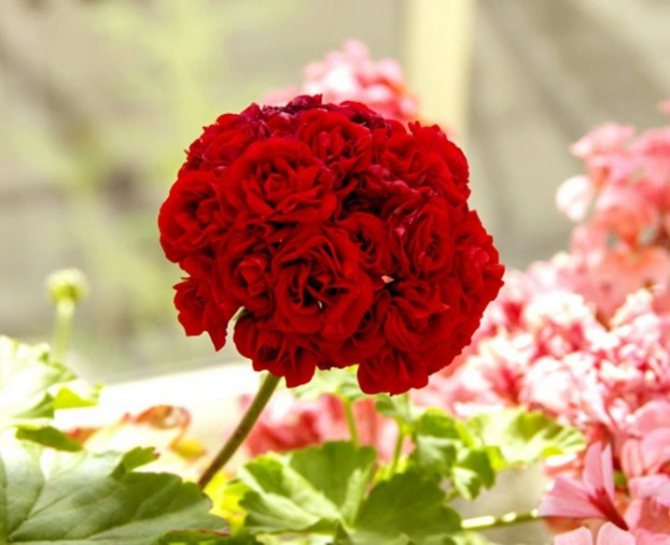

Care and maintenance
Pelargonium rosebudnaya turned out in the process of random mutation and subsequently became the object of serious selection, which led to the emergence of very strong varieties that combine the hereditary characteristics of zonal, ampel and dwarf varieties.
Ground and flower pot requirement
Like all pelargoniums, this species prefers small pots, preferably ceramic and not covered with glaze. In such a pot, the soil dries out better and more oxygen enters the roots. The soil can be purchased from a specialty store or made by yourself. It should not be overly saturated with nutrients and contain ingredients such as sphagnum that can retain moisture. It is better to choose a ready-made soil designed specifically for pelargonium. When purchasing all-purpose potting mixes, you can add perlite and sand to increase looseness.
You can create a good soil yourself. It should include:
- peat soil - 2 parts;
- sod land - 4 parts;
- river sand - 1 part;
- perlite -1 part;
- leaf humus - 2 parts.
Watering
Watering should be moderate, because pelargoniums suffer most from overflow and stagnation of water. They tolerate long drought easily due to their thick leaves capable of accumulating and retaining moisture.
Illumination
Representatives of pelargonium live well in bright sun and partial shade. Will grow well in the south, southwest and southeast window. In the garden, they can be placed on open rock gardens, hung on the balcony and veranda in flowerpots, planted under the crown in the partial shade of a tree. With a lack of light, the leaves become light, the stems stretch out and lose their foliage, flowering will come later or not at all.
Temperature and humidity
Despite the fact that the plant is native to southern Africa, it perfectly adapted to indoor and outdoor conditions in the summer. But do not expect that pelargonium will feel great in the heat. Temperatures above 28 degrees and bright sun will harm the plant, make it sluggish, and the flowering period will be halved. Delicate petals may fall ahead of time.
In winter, like all pelargoniums, wild geraniums need rest. In order to lay flowering buds, it is necessary to arrange wintering with a temperature drop of up to 10 degrees. The temperature in the room should not exceed 15-16 degrees.
Pelargonium is one of the most undemanding plants to humidity in the room. It easily tolerates dry air, and in winter, in rare cases, dry leaf edges will indicate a lack of moisture. It is not recommended to spray the plant. Drops accumulate on the leaves covered with villi, which can lead to decay. The plant can be placed on a pallet with pebbles and water. The second way to humidify the air is to put it in a larger planter, laying wet moss between the walls.
Fertilizers
Starting from the end of February, the flower is ready to wake up and leave the dormant period.At this time, he needs fertilizers containing nitrogen. They will help form a lush green mass, a branchy stem and a luscious green color. With the third or fourth feeding, the fertilizer should contain more potassium and phosphorus. These minerals help produce abundant and long lasting blooms.
Bush formation
Pruning of rosebud pelargonium is carried out twice a year. Autumn formation is the strongest. Old bare shoots are cut off, strongly elongated ones are shortened by 2/3 or 1/3. In the spring, before the start of active growth, the pelargonium is pinched very carefully. Spring pruning is strong, may delay flowering or rob this year of flowers.
Diseases and pests
If pelargonium looks unhealthy, you will have to figure out the problem and take measures to return a joyful, elegant look to the green pet.
- The leaves begin to turn yellow if the air in the room is too dry and there is little light - the bush needs to be rearranged to a more suitable place.
- The flower is lethargic - there is excess water in the root system. It is advisable not to water any longer.
- If the roses begin to dry out quickly, the plant kills the fungus. Can be treated with "Fitosporin" (twice at weekly intervals).
- The appearance of brown spots on the leaves indicates a bacterial infection. We'll have to transplant it into fresh soil, water it only in the morning and treat it with fungicides.
- If aphids or whiteflies have settled on a bush, this can cause the death of the flower. To avoid this, you need to treat it with insecticides.
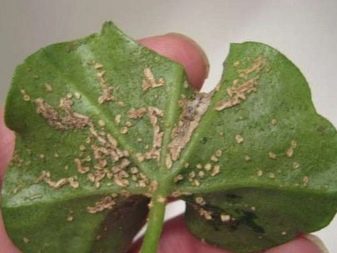

With the exception of some varieties, pelargonium does not require much effort for its use. Experienced growers easily cope with problems in its maintenance and pest control. The beauty of the roses that this flower bestows on justifies efforts to keep the plant healthy.
Diseases
Pelargonium Australian pink is susceptible to diseases standard for this family:
Of the pests, the danger is:
Next, we will consider in detail what to do if a flower develops a disease.
Bacterial and fungal
Pathologies of this kind appear in Australian pink more often than others. Fungal and bacterial diseases usually appear in the form of a spot that affects the leaves of the plant. There is no salvation from diseases such as root and stem rot - the plants will have to be destroyed by cutting off the top for further reproduction.
But some types of spots can be cured by applying systemic fungicides for this. Spraying with a weak aspirin solution can also help. Those leaves that are affected by the fungus must be removed.so that the disease does not spread further.
Pests
As mentioned above, most often Australian pink is affected by whiteflies, ticks and aphids. To prevent the defeat of these pests, it is recommended to regularly examine the underside of the pelargonium foliage for the presence of insect larvae and eggs. If the pests have already appeared, wash them off with soapy water, and then spray the bush with a suitable insecticidal preparation.
Origin
Pelargonium Rosebud belongs to the family Pelargonium x hortorum, to garden pelargonium. The origin of this species was identified in the 19th century in Europe, in France. At the same time, the plant came to the territory of the Russian Empire. The origin of the species is associated with a random mutation.
The plant first appeared in 1850 and spread throughout Europe. Pelargonium rosebud was especially fond of in England during the Victorian era. Flowers were used in the manufacture of boutonnieres and bouquets.
Growing from seeds
For many, growing pelargonium from seeds is a long process. Planting begins around the end of February. Seeds are planted in moist peat soil, under a film. The first seedlings appear within 5-7 days. Then you need to give a few days to root the plants, you can start picking. Now all that remains is to wait for the plant to get stronger and begin to bloom.


Specifications:
| Package height, cm | up to 20 cm |
| By pot size | Pot diameter 9 cm |
| Manufacturer | Egoryevsky greenhouse plant |
| Country of manufacture | Russia |
Plants are living organisms, as a result of which they require care and attention. They need watering, weeding, loosening, fertilizing, pruning and garter. All on time and with great care. Then the plants will thank you with their beauty.
Rare, rosaceous and tulip-shaped pelargonium has abundant, lush flowering for 5-6 months, is drought-resistant, blooms in the shade and in the sun.
the nearest possible delivery date is 04 october
up to 5 kg - 350 r. from 5 to 10 kg - 450 RUB from 10 to 20 kg - 550 RUB further + 20 rubles / kg Fragile cargo + 50% of the shipping cost
Delivery across Krasnoyarsk from 499 rubles.
The minimum order in our store is 1000 rubles.
Botanical description
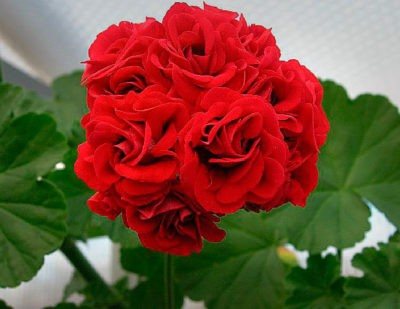

Outwardly, the plant resembles a shrub, reaching up to 80 cm... in height. The leaves are large, dense, dark green in color. The surface of the leaves is covered with a small fluff. The inflorescences of the plant are large and lush. The inflorescence consists of small flowers with a large number of petals. The flowers are collected in the form of a large ball. Each individual bud in the inflorescence looks like a rosebud, hence the name - rosebud.
Pelargonium rosebud is sold in flower shops, gardening departments, in household hypermarkets. The cost of a rooted cuttings is from 300 rubles per piece. Particularly beautiful plants, valuable varieties, can be at a price of 500 rubles. per plant and above.
Features of care for pelargonium
In order to enjoy the long flowering of the plant, it should be planted in small pots.
If the flower is kept at room temperature year-round, it will bloom less often. For example, the ampelous species blooms in mid-summer and fades in mid-autumn. It is necessary to ensure that the rosette is not in a draft, or close to heating devices. There is an opportunity to plant pelargonium in the ground in spring, when the weather is warm and favorable for this. Allow the plant to bloom more luxuriantly until autumn, and then transplant it back into the pot. Flower pruning should be done in early spring (March). If the plant is on the street, you should not allow the attacks of aphids, spider mites, while using special means for pest control.
Appearance and features
Outwardly, pelargonium looks like a powerful, sturdy plant. The bush can grow up to 80 cm. The varieties have a common feature - the presence of double petals. They do not have the opportunity to open up to the end, than outwardly resemble a rose.
Rosebuton pelargoniums have a very diverse appearance. Breeders bred species:
Today, there are even ivy hybrids that combine the qualities and appearance of three plant species at once. Plants classified as zoned, tall and strong, with powerful stems, dense leaves. Ampel types of a flower are decorated with leaves of a dense structure, outwardly resembling a glossy surface, when flowering they look like a cascade of inflorescences.
Dwarf species are preferred for planting and keeping a house in a pot. This type is distinguished by the unnecessary formation of a bush and pruning, while it blooms profusely and densely in indoor conditions. A feature of some varieties is the white border of the petal, which sets off a double flower. At the same time, certain species have the peculiarity of changing the color color depending on the care, conditions of detention, feeding.
Advantages and disadvantages
Like any other flower, the australian pink rosebud geranium has its advantages and disadvantages.
Among the advantages are the following points:
Pelargonium Swanland Pink is unpretentious to soil and irrigation
Pelargonium also has disadvantages. For example:
- Low frost resistance;
- Specific smell;
- Fear of waterlogging;
- Propensity to disease, etc.
Despite the large number of disadvantages, compared to other plant varieties, with proper care and maintenance, they can be avoided. The most important thing is not to forget that the plant needs diffused light and moderate watering, and even a novice gardener can successfully cope with its development.
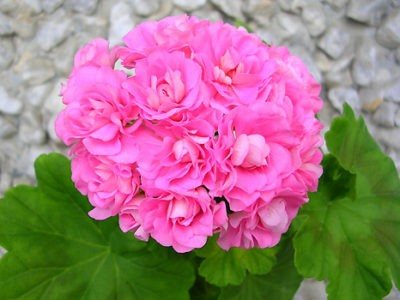

Rosebud Pelargoniums are one of the brightest representatives of this graceful flower family.
The most popular variety among florists remains the Avtralian variety. He is absolutely not picky about care, and his bright and fragrant flowers will not leave anyone indifferent.
In this article, you will learn how to properly care for, plant and propagate this amazing Pelargonium variety.
Common varieties of rosebuds and their photos
We suggest that you familiarize yourself with the description of especially popular varieties, as well as see photos of plants whose flowers resemble roses.
Rose of Amsterdame
Refers to the zonal miniature type. Has beautiful double flowers. At the beginning, the flowers bloom in white, as they ripen, they acquire a pink tint. In one inflorescence cap, there can be two colors at once - white and pink, which gives a special sophistication and beauty. Inflorescences are small, but densely planted. Abundant flowering during the summer season.
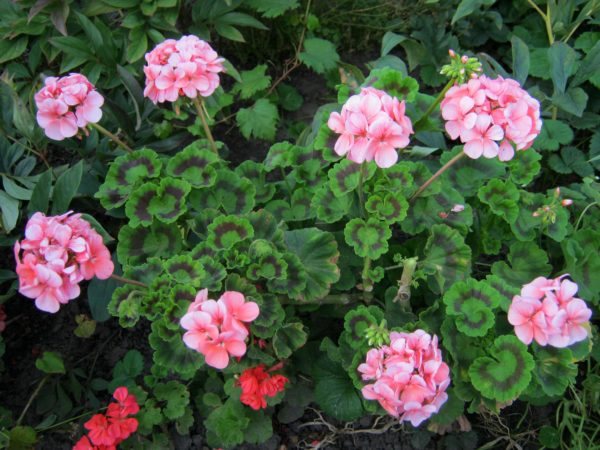

Supreme
The Rosebud Supreme plant differs from other species by a very late onset of flowering, but having entered the flowering season, it dissolves a huge number of inflorescences, each of which outwardly looks like a ball covered with small rose buds of a beautiful red color. The bush of the plant is powerful, strong, tall. Feels great on the windowsill and outdoors in the summer. Not whimsical in leaving. On the reverse side there are terry petals of a lighter shade.
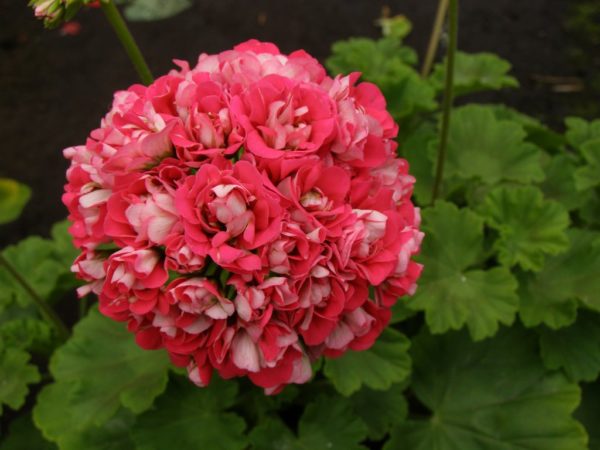

Apple Blossom
The Apleblossom rosebud plant grows very quickly and, without careful and frequent formative pruning, grows into a long, powerful bush. The plant blooms magnificently. Inflorescences are distinguished by their originality of color. In the middle there are green-white petals, then the color changes to white, and the edges are pale pink.
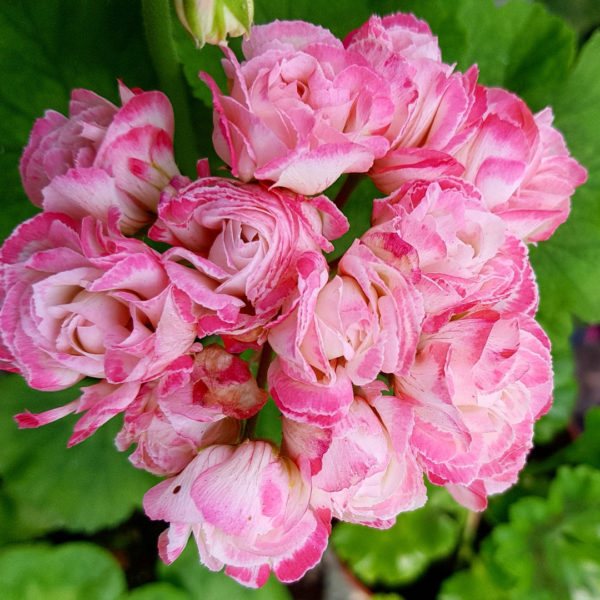

Vectis
The bush of this species is compact, lends itself to easy formation, and the flowering is long, abundant. With the beginning of spring, inflorescences form, turning into flowers of a rich red color. The outer side of the petal is much lighter than the inner one. The plant blooms for a long time, retaining the uniqueness of its shape throughout the entire flowering period.
Rooting cuttings of rosebud pelargonium
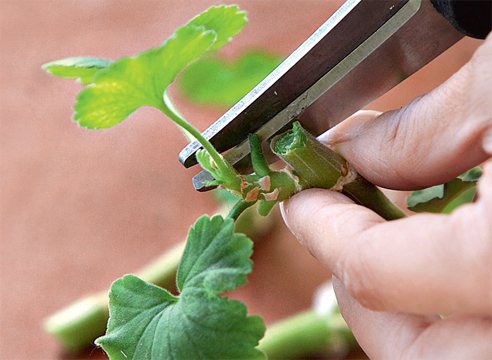

Reproduction of rosebud takes place both by seeds and by cuttings. The question of whether pelargonium reproduces by seeds is in the affirmative, but in this case, the plant will not inherit parental qualities. It is better to learn how to propagate pelargonium by grafting than to fail in the future. The most suitable time for this process is the beginning of autumn and the end of summer, namely March-April, August-September. Although there are no special restrictions, and rooting of pelargoniums can be done almost all year round. For winter, this process is somewhat more complicated, as for summer, due to the peculiarities of the plant hibernation and its flowering in the summer.
At the beginning, you need to make sure that the rosebud is not overfed with fertilizers, and the soil is well moistened. Then pick up a stalk with two internodes (more is possible), the length should not be less than five centimeters. If you choose a weak herbaceous cutting, it can lead to rotting of the plant. It is cut off with a sharp sterile blade, all excess is removed (stipules, peduncles, leaves). It is necessary to dry the cuttings within one hour.
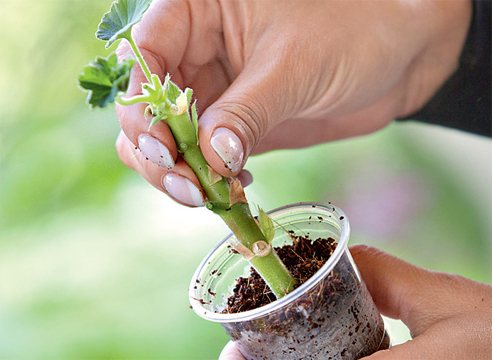

The next equally important step is soil preparation.There is a certain composition, which includes: river sand, earth and peat tablets. Before planting, it is necessary to treat the sections of the plant with a special agent, depending on the season.
Care should be taken that there are planting indentations in the peat tablets or prepared soil, where the plant is located. Then it is placed in a plastic cup. Near the handle, peat can be slightly compacted. Watering is moderate, use little water, pour along the edge of the glass. Then the cups with cuttings are placed in a bright place where direct sunlight does not penetrate. The rooting period can last up to one and a half months, depending on the type of pelargonium. If, nevertheless, this process fell in late autumn, or the beginning of winter, it is better to first make sure that they have enough lighting (use additional lighting lamps). The optimum temperature is considered to be up to twenty degrees. At the same time, it is not worth covering them with anything.


As soon as the erupted roots become visible, you can think about transplanting them from pills into glasses. For those cuttings that do not have visible roots, you need to cut off the mesh. After another week, the roots will already be clearly visible in the glass, at which point it will be possible to transplant the plant into a pot. This is just one of the options: how to root pelargonium, in fact, you can try different means and methods and choose the most suitable one for yourself. When planting, the seeds of Pelargonium rosebud should be placed at a distance of at least five centimeters from each other and adhere to the temperature and humidity conditions. It is necessary to wait for the appearance of at least two leaves on a new plant in order to transplant it into special containers.
At this time, the reproduction of pelargonium, the breeding of pelargonium, which breeders are engaged in, made it possible to breed a hybrid of a zonal and ivy plant, the so-called Ivy hybrid. Their main advantage is a short stem and a larger flower.
Growing at home
Pelargonium rosebud can grow both at home in a pot and in a flower bed in the garden. For planting a plant at home, it is important to use light, loose soil mixed with sand. Drainage is laid at the bottom of the pot.
Rosebud pelargonium feels good indoors at a temperature of 18-25 degrees. In winter, the temperature should be 10-12 degrees. The plant is demanding for light. The flower pot can be kept on the east, west, south side. Shade and partial shade are undesirable, this makes flowering not abundant.
Where and how to plant?
Before planting a plant, you must perform a number of preparatory steps.:
- prepare material for planting;
- choose a landing site;
- equip a pit for planting.
Lighting and location
If there is a lot of direct sunlight on the site, then the color of the flowers will be bright. If you grow a plant at home, then it is best to choose sills of the southern direction.
Since pelargonium Avtralian belongs to thermophilic crops, the planting site should also be protected from wind and drafts. There should be no stagnation of water on the site, since the root system of the plant will begin to rot from waterlogging.
The planting process is as follows:
- Dig a hole, lay drainage with broken bricks, gravel or small stones. Pour soil mixture on top, obtained by mixing garden soil, peat and quail manure. Take all components in equal proportions.
- Place the seedling in the planting hole, and slightly compact the soil around it.
- At the end, water the plant and lay a layer of sawdust mulch.
Soil requirements
When growing pelargonium Avtralian, it is necessary to prepare a light and permeable soil.
Watering
Pelargonium Avtralian tolerates dryness better than waterlogging... Water the plant regularly, but in moderation. Low humidity remains an important health condition for the roots.Use only warm and settled water for irrigation.
Top dressing
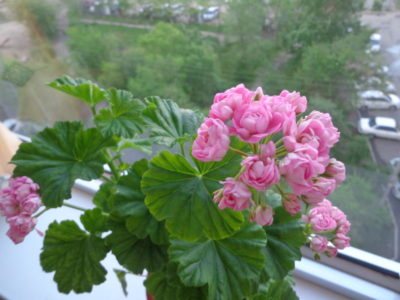

Nutrition affects the duration and abundance of flowering. You can add the following compositions:
- Liquid mineral fertilizers with increased concentration of phosphorus and reduced nitrogen. It is necessary to introduce such a composition during the period of active growth of the bush. Before this, the plant must be watered, otherwise you can burn the roots.
- Potassium. It is necessary for abundant flowering.
You can buy fertilizers at the flower shop. and use them as directed or use rotted compost.
Pruning
Thanks to this procedure, the following effect is achieved:
- a bush with a compact crown is formed;
- more buds of inflorescences are formed;
- parts of the plant affected by the disease are removed;
- high-quality planting material is created.
To get a lush bush with side shoots, you need to pinch the bush. This is a procedure during which the tops of young shoots are removed. Removing dead buds promotes abundant flowering.
Transfer
Pelargonium of the considered variety is actively growing, so it must be transplanted into another container. It is recommended to transplant in the spring, while the active growing season of the flower has not yet begun. You need to choose a pot that is larger than the previous one. Otherwise, Avtralian will not bloom, but will go into the green mass. After transplanting into a new pot, the bush should not be fed for 1-1.5 months. In the new substrate, the nutrient components will be enough for the first time.
Outdoor cultivation
Soil and Lighting Requirements:
The site must be well lit. It is important that the sun's rays are not too active and the plant does not get burned. To do this, you can create a small artificial shade during the hot period.
The composition of the soil needs light, loose, not dense, the clay content is minimal, the soil is too dense, will not give sufficient air to the roots.
The ways
Pelargonium should be planted outside using seedlings or transplanting an adult plant from a pot into the ground.
Outdoor planting is possible only with the onset of stable heat, without possible frost.
Benefits of Landing Outside
The abundance of sunlight heals the plant, makes its color brighter, the bush is stronger, the flowers are richer.
In open ground conditions, the natural hardening of the plant occurs.
Cuttings on the street take root faster and easier than in a pot.
Landing rules
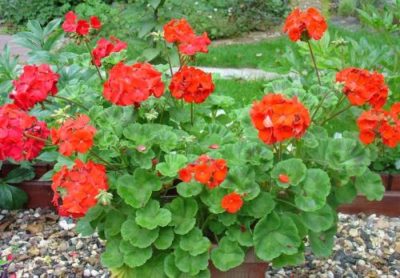

If it is necessary to plant an adult bush on the street that has wintered indoors, this requires certain rules:
- With a strong growth of the plant, it must be cut off. It is important to comply with the deadlines, to do it in February or early March.
- The pruned bush should be placed on the sunniest side.
- It is necessary to carry out a number of dressings.
- It is required to increase the watering of the plant, preferably through the pallet.
- After the onset of stable heat, the plant is transplanted into open ground by transferring an earthen clod from the pot to the ground.
Pelargonium rosebud feels good in outdoor conditions... The basics of flower care are not complicated.
Watering
The plant requires watering as the soil under the bush dries up. It is easier for a flower to tolerate aridity than excess moisture. Too much watering leads to the development of fungal diseases, decay of the root system. It is better to water the plant earlier in the day.
Top dressing
Rosebuds bloom for a long time and profusely, for this they need a lot of strength. A great help to the flower will be the introduction of mineral fertilizers once a month during the entire flowering period. The plant does not need to apply nitrogenous fertilizers. When fertilized with nitrogenous fertilizers, a bush and green foliage will grow, which will not allow flowering. It is better to leave the introduction of nitrogenous substances into the soil for the fall, after the flower has been transferred from the garden to the house.
Plant characteristics
Pelargonium Australien Pink rosebud has a stem and leaves of rich green color, which emphasizes the delicate pink peduncles extremely favorably. The leaves are characterized by a corrugated edging. This is a bush type perennial plant, belongs to the medium-sized varieties. The buds completely bloom extremely rarely, subject to optimal temperatures, which should not exceed 30 ° C. The peculiarity of the Swanland Pink variety is that the flowers do not crumble, despite the very large number of petals.
The plant is unstable to low air temperatures. This variety was produced for growing indoors or in greenhouses, in extreme cases. For the winter period, the greenhouse plant requires shelter. It tolerates a long absence of watering. Even with a prolonged absence of moisture, it produces a large number of side shoots. The bush is strong, unpretentious to soil and water quality. The only requirement of Pelargonium Australia Pink Rosebud is watering with water that is at room temperature.
Read also: How to remove bedbugs with home remedies
Important! It is not recommended to water the plant frequently. Enough once or twice a week. Watering should not be plentiful, as rot may appear on the root system, this is fraught with a serious disease of the flower.
Pelargonium Australian Pink Rosebud forms lush inflorescences with large peduncles reaching 3-4 cm in diameter. One shoot can contain up to 5 inflorescences. The petals of the buds are terry, the outer side is a tone lighter than the inner one. The flowering period is quite long, even when compared to other varieties of pelargonium.
Pelargonium Swanland Pink is not resistant to low temperatures
Common problems
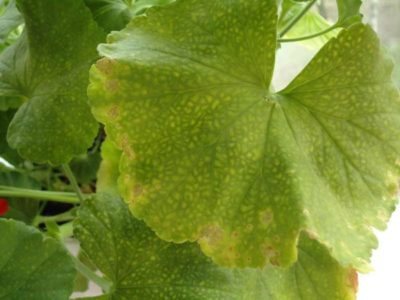

Pests and parasites. Aphids or whiteflies can settle on a pelargonium bush. The parasites will suck out all the juices from the plant, which will lead to the death of the plant. It is important to treat the bush with insecticides.
Plant disease. Most often, the plant is spoiled by gray mold. When mold develops, it is important not to water the flower.
Yellowing and drying of leaves. The plant lacks moisture. The water may not be reaching the roots. Mulching will help.
The leaves are lethargic, falling off. Excess moisture. Thinning the plants can help.
Does not bloom. This may be due to a lack of light and feeding. It is important to ensure the presence of a bright diffused color and regularly apply mineral fertilizers for flowering plants.
The flowers dry up. Perhaps a fungus has started. Treatment with Fitosporin or watering with 5% Bordeaux mixture will help. The presence of rusty, gray spots, white fluff on the leaves may also indicate a fungus. It is important to provide loosening of the soil for air intake and antifungal treatment.
Bacterial contamination. Brown spots will appear on the plant. It is important to transplant it into a different soil, apply fungicides.
Breeding features
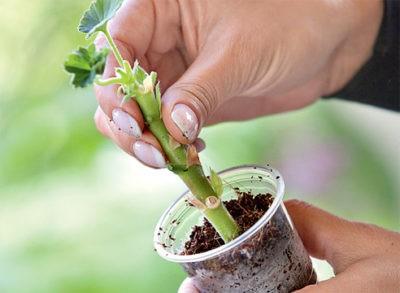

This plant is quite gentle, therefore it can show whims during reproduction. You can propagate by cuttings and seed methods, but when using the latter, the plant does not inherit the qualities of the parent bush.
You can cut rosebud geraniums in any season. But the best time is March-July:
- A half-lignified stalk with 3-5 internodes should be cut from the main plant. Herbaceous green will not take root.
- Only store land is suitable, because it is disinfected. You also need vermiculite.
- A mixture of vermiculite and earth 1: 1 should be poured into transparent plastic glasses.
- Plant prepared cuttings in it. The preparation is simple - the stalk needs to be cut, the leaves are removed as much as possible (only the rudiment of the leaf is left). The cut is slightly dried (30-40 minutes in the air).
The key to good rooting is cleanliness and fresh soil. In the early days, the stalk is watered very carefully - it cannot be overdried or poured over. The plant takes root for 2-3 weeks under the lamp. After the appearance of the first roots, you can fill up the fertile soil.
The best varieties of rosebud geranium
Breeding work gave birth to a large number of varieties that differ in color and shape. Some geraniums have not only beautiful flowers, but also very interesting leaves.
Some of the most beautiful varieties include:
- Bornholm - red rosebud geranium;
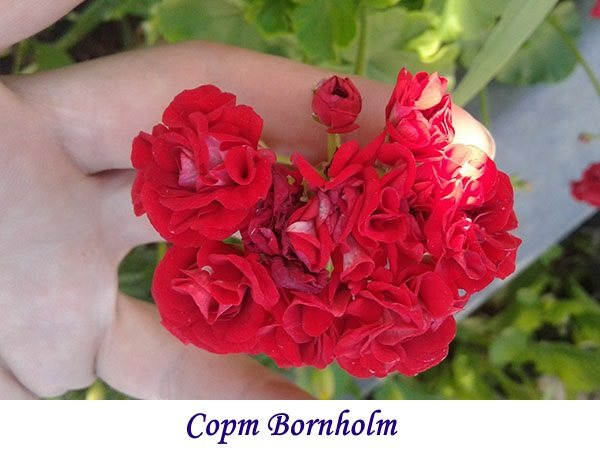

- Lady Gertrude with a very delicate color of flowers;
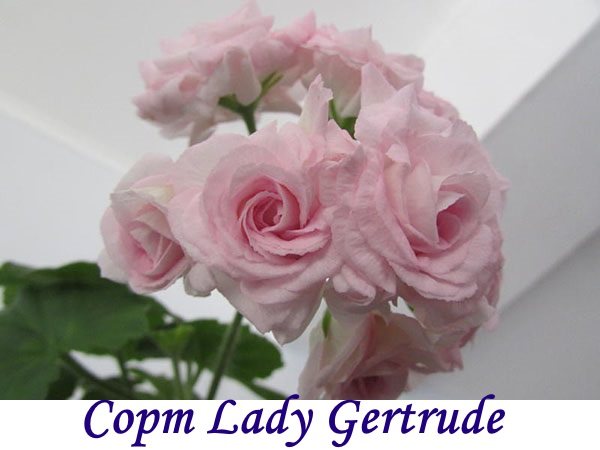

- Appleblossom Rosebud - White flowers with pink edging
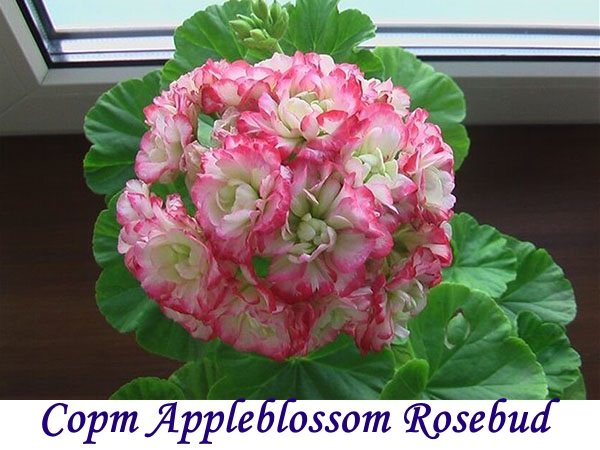

- Noel Gordon - with original, twisted petals on the flowers;
- Millfield Rose with pink and lilac "roses";
- Ice Rose variety;
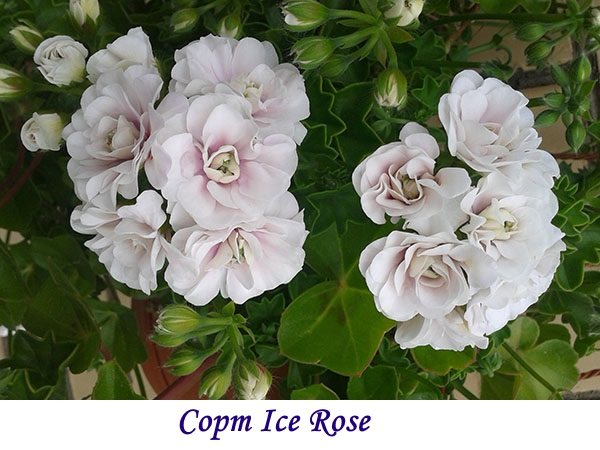

- Geranium Grainger's Antique Rose;
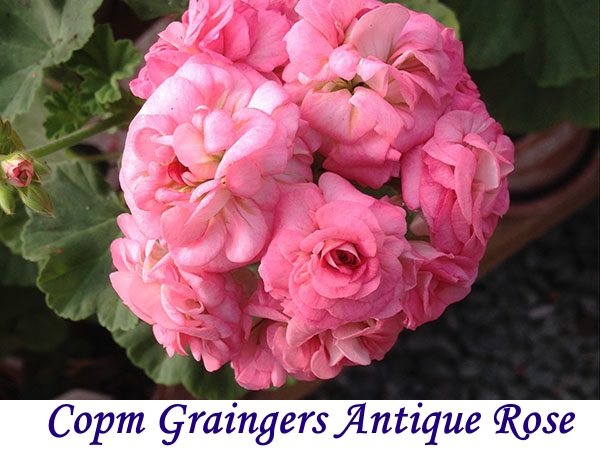

- cultivar Marbacka Rose;
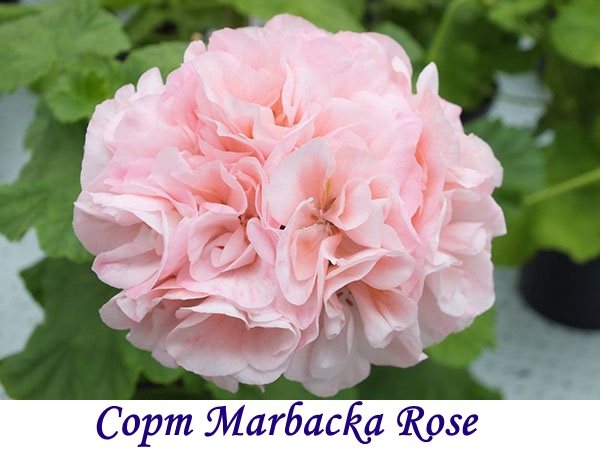

- rosewood geranium Denise variety;
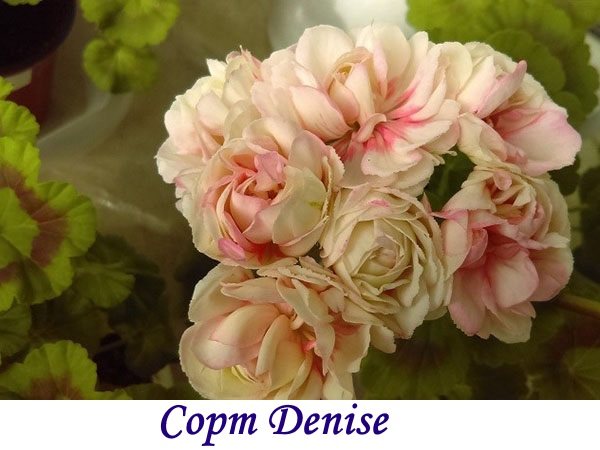

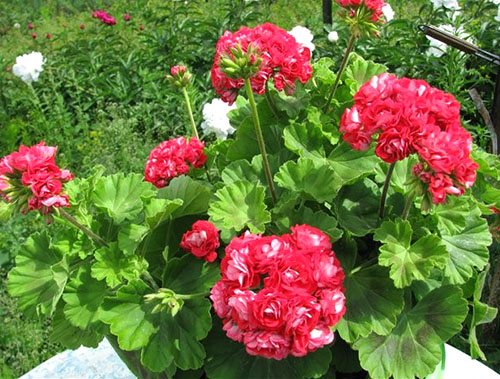

Among pelargoniums, as well as among people, there are stars and celebrities. Zonal Pelargonium Pink Rambler is one of the most famous varieties of rosaceous plants. Unpretentious, lushly blooming powerful bushes are deservedly loved for their beautiful corrugated foliage and bright pink-carmine flowers. Pelargonium flowers, so similar to tiny garden roses, are collected from spectacular inflorescences, the volume of which is given by the light underside of the petals and the stunning shape of the buds.
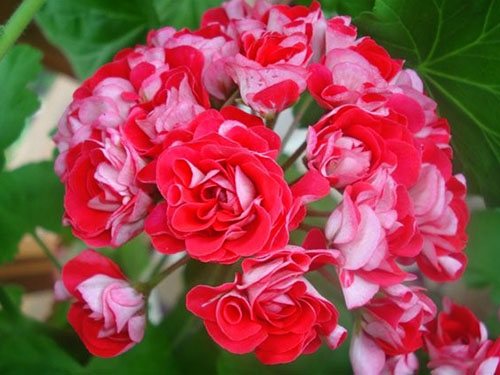

When growing a variety, it is important to remember that rosaceous varieties form inflorescences a little later than other zonal plants.
Necessary lighting
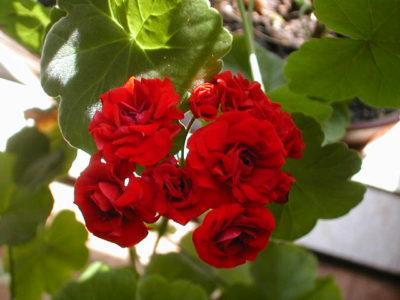

The room should be well lit throughout the day.- Direct sunlight and overheating of the soil and plants are not allowed.
- Do not allow burns on the leaves.
- Dark and shaded rooms should be avoided, since geranium is a photophilous plant.
- It is necessary to monitor the temperature of the room. The optimum temperature for this pelargonium is + 17- + 23).
Photo
Below you can see a photo of a rosaceous geranium of red, pink and other shades. RosebudRed
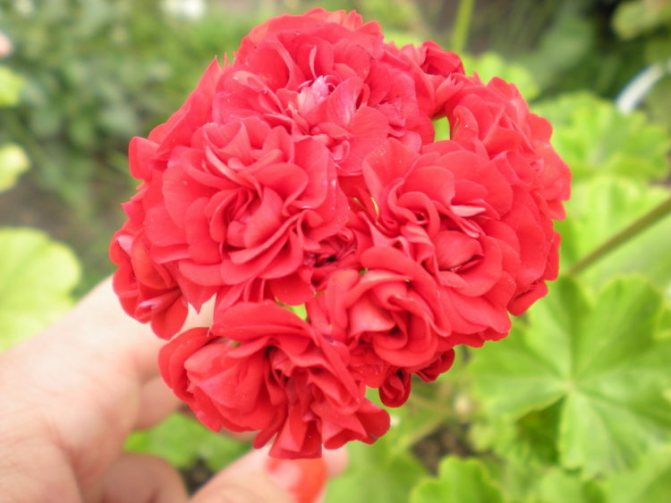

Rosita (PAC Viva Rosita)
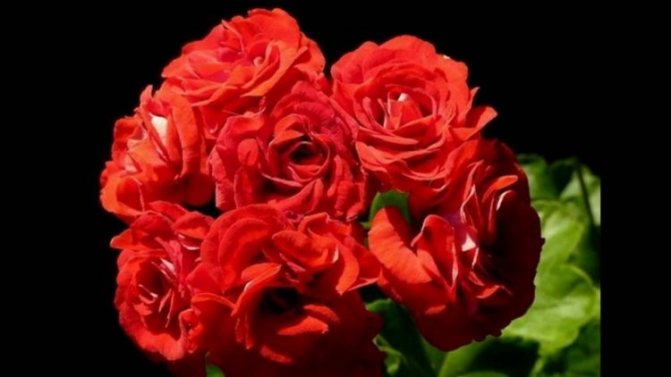

Bornholmpelargon
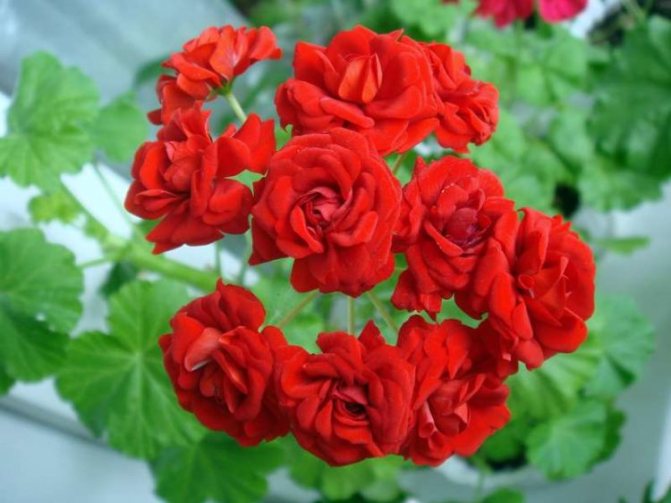

Royal geranium
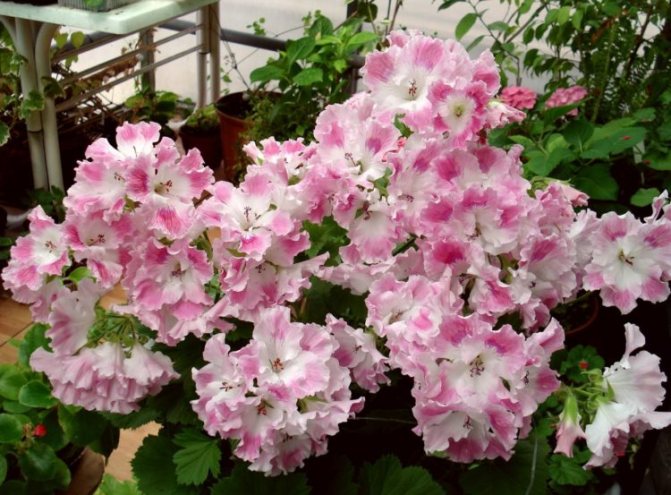

Pelargonium Denise


Zonal, terry Denise pelargonium forms large, vigorous bushes, which are annually decorated with bright caps of peach or pink flowers. Densely double flowers in the form of half-open roses are very large, and the corollas do not open until the end of flowering. The middle petals are light, delicate in color, and the lower layers are brighter. At the point of attachment of the petal to the peduncle, the color may be greenish.
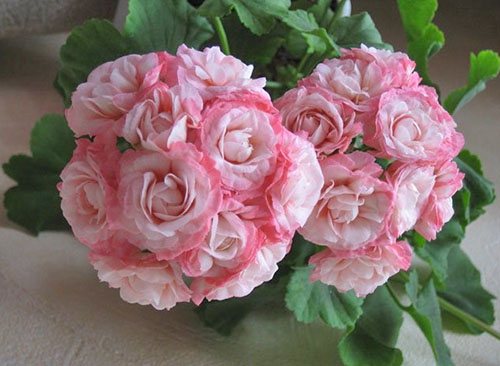

This variety is famous for its beauty, abundant flowering and a grateful attitude to care. Pelargonium is unpretentious and easy to form.
Pelargonium Millfield Rose
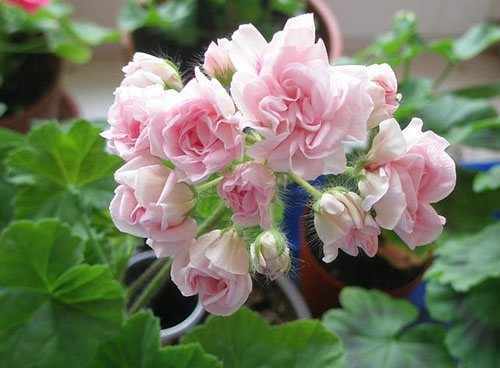

Large, powerful shrubs of Pelargonium Millfield Rose belong to the class of Ivy-hybrids. This means that the plant has features of both ivy and zonal pelargonium, which is reflected in the shape of the leaves and the nature of the growth of the shoots.
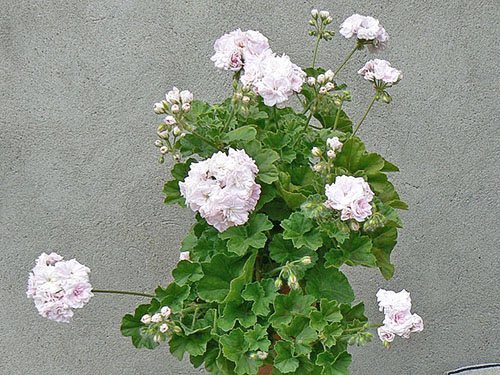

The inflorescences, consisting of double pale pink roses, are quite voluminous and heavy. The stems have a lot of beautiful bright foliage. In good light, a brown zone is noticeable on the leaf plates. If the peduncles are not tied up in time and the plant is not formed, it quickly becomes ampelous. For the rest, caring for the variety is not difficult and even a beginner can do it. But the reproduction of bushes may require special attention, but the desire to see the luxurious flowering of pelargonium on your window will certainly help to overcome all difficulties!
What it is?
Rosebud geranium is a spectacular representative of double hybrids with graceful flowers, collected in lush inflorescences, reminiscent of small spray roses. The color of the buds is different:
- white;
- pink;
- blue;
- red.
The flower is quite unpretentious, the main thing is to provide it with proper care:
- water and fertilize the plant in a timely manner;
- maintain the required temperature and humidity in the room.
South Africa is considered the birthplace of the rosebud geranium. Back in the 18th century, the flower was brought to Europe, and in the 19th century, it was isolated as a separate species. The origin of the rosenbud geranium occurred by crossing with other species of the same culture.
What breeding method is suitable for rosebud geranium
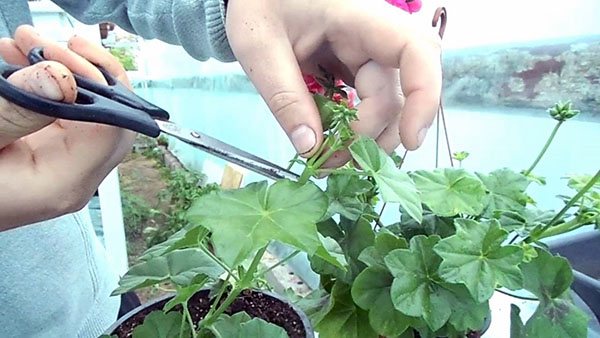

Geraniums can reproduce in two ways:
Since with the seed method, new plants do not inherit all the properties of the parent, rosebud geranium is bred by cuttings. The best time for this is from early spring to mid-summer. To do this, a small stalk with several internodes is cut from an adult plant.
For planting cuttings, a light soil is prepared, with the addition of peat. Or prepare special tablets for rooting the formation of roots.
Procedure:
- The cuttings are dried for 60 minutes.
- Remove the lower leaves.
- They are buried in the ground so that one internode is in the soil mixture.
- The peat around the cutting is slightly compacted.
- The container is placed in a bright place at a temperature of about + 20 ° C. If the days are cloudy, it is necessary to arrange sufficient artificial lighting.
- Watering is moderate, it is carried out away from the trunk.
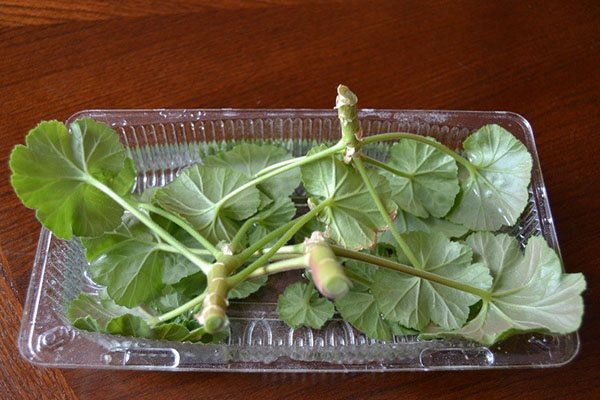

If all conditions are met, roots appear in 15-20 days. If the plants have been planted in tablets, then you can place them in glasses for further growth. When there are more roots, the cutting is transplanted into a flower pot.
Whether or not to cover the cuttings with polyethylene, each grower decides for himself. This circumstance does not affect the rooting rate.
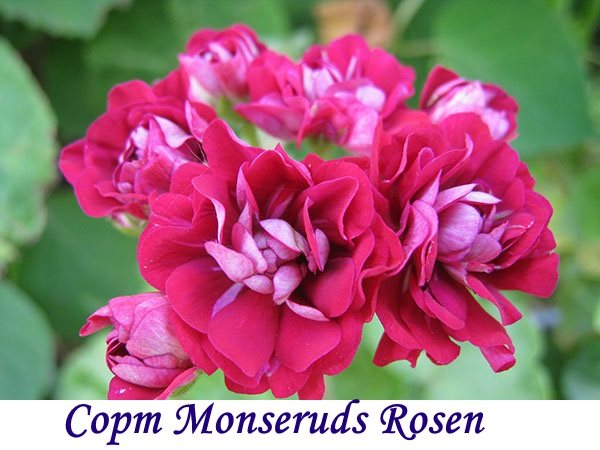

If it was customary to use a bag on top, it is necessary to ensure that excessive moisture does not collect under it. Cuttings of rosebud geranium, with proper home care, are well accepted, allowing you to get new plants.
The stem for planting must be correctly selected. If an immature shoot is cut, without semi-lignification, such a cutting in most cases rots.
Pelargonium rosebud is an attractive flowering plant that is distinguished by its elegance and unusual beauty. This type of geranium for breeding is chosen by true connoisseurs who are ready to care for a plant with unusual beautiful flowers.
Pruning outdoor and indoor pelargonium
Trimming is necessary formative. For outdoor pelargoniums, a sanitary procedure is recommended at the end of autumn, when the plant stops blooming. It is completely cut off under the "stump" and left to winter in a cool room. In indoor perennials, elongated stems are cut, leaving small branches up to 10-15 cm long. The cut shoots can be used for vegetative propagation of pelargonium by cuttings.
Use complex formulations as fertilizers. Feeding for home flowering plants is suitable. During the flowering period, focus on potassium and phosphorus. In no case do not use fertilizers in which there is a high nitrogen content, otherwise pelargonium will not bloom and will begin to grow strongly.


Spraying the plant is not recommended. It is believed that water on the leaves is the cause of gray mold and rot. But, in fact, the main reason for this ailment lies in dust and dirt. Dirt can be removed as needed with a damp cloth.
What care does rosebud geranium need?
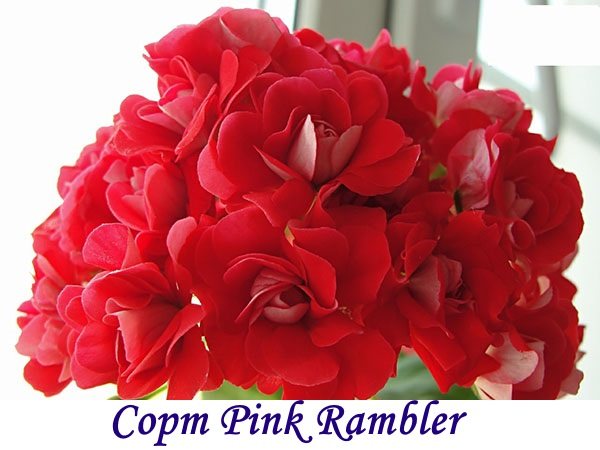

With proper care of the plant in a greenhouse or at home, pelargonium pleases with a beautiful appearance and abundant flowering.
Basic requirements for caring for rosebud geraniums:
- shading from direct rays of the sun;
- moderate watering.
Violation of these rules can provoke a deterioration in the appearance of the flower and a decrease in the intensity of flowering. Do not flood a houseplant with water, it may die because of this. In winter, if the plant is not in the room, it needs to create a suitable temperature regime - not lower than + 10 ° C.
A flower transplant is best done in mid-spring. In the future, care will be reduced to timely soil moisture. The soil can be purchased ready-made, designed specifically for pelargonium, or you can compose it yourself.
The soil mixture should contain the following components:
Maintaining the decorativeness of the plant requires periodic renewal, which must be carried out no later than once every 5 years.
Indoor pelargonium, if possible, can be transplanted into open ground for spring and summer. This will enable the plant to bloom beautifully and luxuriantly in the warm season. In the fall, geraniums can be transplanted into a pot again and brought indoors.

